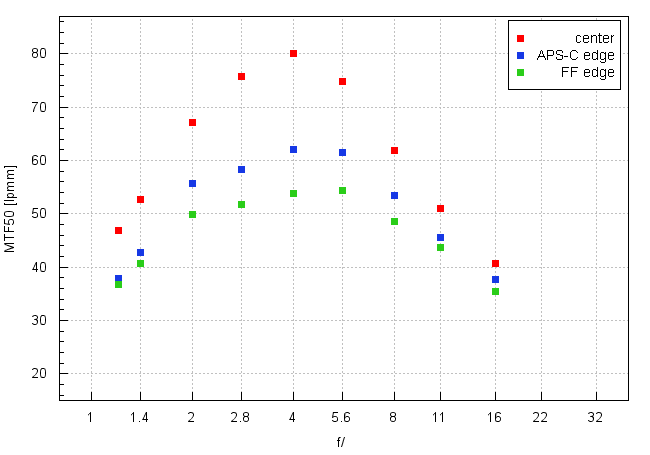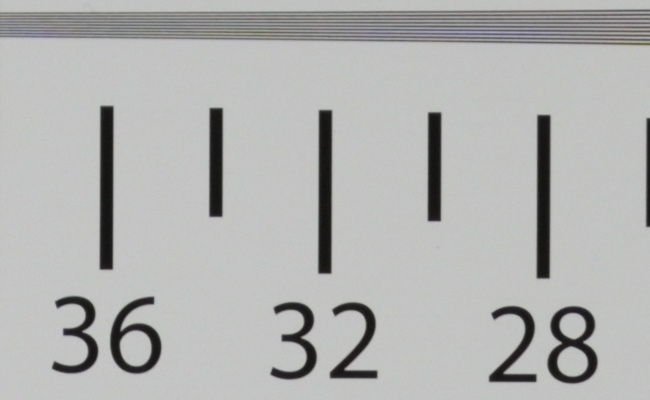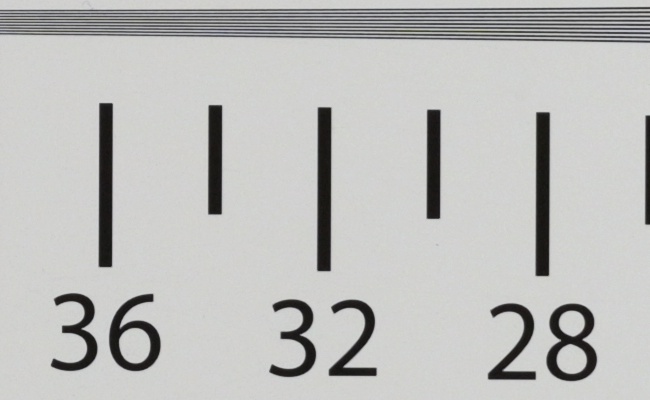Nikon Nikkor Z 50 mm f/1.2 S
4. Image resolution
Let's check how the Nikkor Z 50 mm f/1.2 S compares – its results in the frame centre, on the edge of the smaller APS-C/DX sensor and on the edge of full frame, presents a graph below.

Please Support UsIf you enjoy our reviews and articles, and you want us to continue our work please, support our website by donating through PayPal. The funds are going to be used for paying our editorial team, renting servers, and equipping our testing studio; only that way we will be able to continue providing you interesting content for free. |
- - - - - - - - - - - - - - - - - - - - - - - - - - - - - - - - - - - - - - - - - - - - - - - -
The performance in the frame centre is really beyond reproach. Already at the maximum relative aperture you deal with values close to 47 lpmm so well above the decency level. With stopping down the aperture MTFs only improve, reaching the peak by f/4.0 where the lens is able to exeed slightly an excellent level of 80 lpmm. It is exactly a performance you would expect from a good quality system prime.
Still there is one small flaw. The shape of the resolution graph reminds me more graphs of older f/1.2-1.4 lenses: a slow increase of the MTFs on stopping down the aperture, a peak near f/4.0 or f/5.6, then a decrease due to diffraction. Newer constructions should have more asymetric graphs, with a better performance on the left. A graph of a modern f/1.2 lens should achieve the peak of its performance in the f/2.8-4.0 range and by f/2.8 its resolution level at least should match that by f/4.0. The Nikkor doesn't fare so well - it's enough you compare its graph to that of the Sony FE 50 mm f/1.2 GM, tested by us not so long ago. The Sony lens near f/4.0 was able to get to 80 lpmm but by f/2.8 it was able to have resolution at a level of about 78 lpmm; at the maximum relative aperture it was almost 70 lpmm so over 20 lpmm more than in the case of the Nikkor. Mind you, both lenses have similar parameters and similar price tags too, and the Sony is smaller and weighs less than the Nikkor so its task was more difficult in this category.
When it comes to the edge of the APS-C/DX sensor once again there are no serious reasons to complain. The resolution by f/1.2 could have been a tad better but, fortunately, the decency level is reached already by f/1.4. Still, once again, if you compare this to the performance of the Sony, the Nikkor fares not so well. The Sony GM 1.2/50 had higher results both by f/1.2 and also on more significant stopping down.
You can describe the edge of full frame in similar terms. The Nikkor needs to be stopped down to f/1.4-1.6 in order to produce images of decent quality. The Sony managed that already at the maximum relative aperture. On stopping down the Sony fared better as well, with maximum results higher by about 8 lpmm.
At the end of this chapter, traditionally, we presents crops taken from photos of our resolution testing chart; they were saved as JPEG files along with RAW files we used for the analysis above.
| Nikon Z7, JPEG, f/1.2 |
 |
| Nikon Z7, JPEG, f/4.0 |
 |






